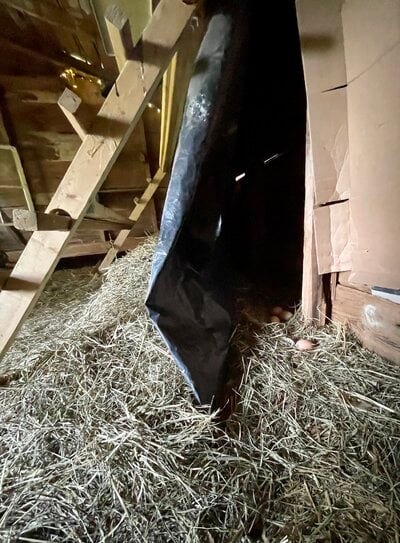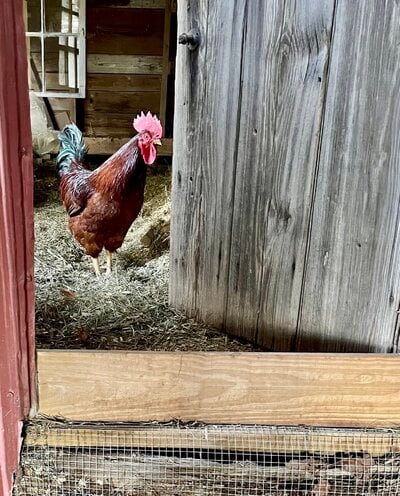This is a good article because it touches on safety, health, keeping chickens warm and the importance of fresh unfrozen water.
Navigation
Install the app
How to install the app on iOS
Follow along with the video below to see how to install our site as a web app on your home screen.
Note: This feature may not be available in some browsers.
More options
You are using an out of date browser. It may not display this or other websites correctly.
You should upgrade or use an alternative browser.
You should upgrade or use an alternative browser.
Caring For Chickens in the Winter
- Author BYC Project Manager
- Publish date
- Article read time 6 min read
- SwampPrincessChick
- 4.00 star(s)
This article explains how to adequately care for chickens during the coldest months, however it does miss a few key points that especially the beginner chicken keeper needs to be aware of. In the second paragraph, the article reads, "Chickens have featherless feet, so they stand on one foot while tucking their other foot into their feathers to keep it warm." While the latter part of this sentence is true, the former is false. There are many breeds of chicken that are feather-legged, such as the Cochin and Brahma, and this needs to be pointed out. Also, it should be noted that this article does not tell the reader that breeds with smaller combs and wattles do not get as cold easily. Overall, this is a good article, but I feel as if it needs a little more.
- Galaxy_rules
- 5.00 star(s)
Great article!
- thecatumbrella
- 5.00 star(s)
Really enjoyed this article. Thorough, yet to the point. Our chickens are in their first winter, and are troopers even in the 20's. When it dips lower, we deploy some of the strategies from this post (cracked corn, BSFL, etc.)
- Debnsync
- 5.00 star(s)
This is a great article that explains why and how to try out the deep litter method that really works for our little flock of seven RIRs. Information here is exactly what we learned about and includes the several reasons we chose to maintain it in the chicken house. This will be the second year going into fall and winter continuing the technique of building up the depth of “bedding”, or “litter” that helps insulate, thus contributing to a warmer environment when our lows in Piedmont of N.C. dip into high twenties to low thirties degree F. It also contributes to insulation against the heat of summer, keeps the unwanted smells away and protects our chickens from bacteria and other unwanted microscopic “critters”.
This has been very successful from the start when we first renovated the old existing chicken house last spring, 2021, and began gradually building up a blend of things over the summer and into the fall that breaks down along with the chickens’ “pooties” we gradually rake and distribute into the mix. I read somewhere prob on BYCs about how to get the chickens’ assistance keeping the mix stirring by scattering out some treats at night so they would wake up to a scratch party!!
It’s usually recommended to go into the colder months with about 12” of the mix for the best results. In the spring it is raked out and removed to a safe spot on the farm where it will further break down. If done correctly it should never smell bad!
Here’s what we have come to work with, ( there may be more recommendations to be found here on BYC and at your local seed & feed stores ): a pre-packaged blend of chopped straw & a natural mineral for cleaner decomposition, a new discovery this summer; pine chips; soft hay; some smaller amounts of D. E. to use sparingly as needed to protect from certain unwanted insects like mites inside the building ; of course the chickens’ droppings; and if available dried fall leaves and dried grass clippings,(of course chemical-free from our yard, and if there is some leftover after putting some out in the chickens’ run, as they like it for improved scratching without mud).
It is important to watch out for dampness beneath the water containers, windows and all around, especially after rainfall. I remove any wet or soaked “litter/bedding” area as it will not dry out quickly enough, and allow the flooring to dry out before replacing and mixing in more fresh litter. We do not usually have problems with moisture or smell of the droppings in the area beneath our chickens’ roosts as it’s raked into the composting litter daily or every 2-3 days from the heavy plastic tarp beneath the roosts; it’s attached up high and behind the top one of the two roosts, extending downward on a gradual slope and behind the lower roost, (securing it on the outer edges of the lower roost and structure), and continues down to the bottom/flooring directly into the litter where we can cover the “pootie” with fresh litter at will then rake from the surface.
BTW there are articles on BYC regarding how to create a safe yet spacious chicken run, and in our case, it is where they may roam around outside of the coop/building til someone decides to be the free-range “babysitter” for even more hours
 ). Best to all, peace to all, stay well and enjoy your creatures at home.
). Best to all, peace to all, stay well and enjoy your creatures at home.
This has been very successful from the start when we first renovated the old existing chicken house last spring, 2021, and began gradually building up a blend of things over the summer and into the fall that breaks down along with the chickens’ “pooties” we gradually rake and distribute into the mix. I read somewhere prob on BYCs about how to get the chickens’ assistance keeping the mix stirring by scattering out some treats at night so they would wake up to a scratch party!!
It’s usually recommended to go into the colder months with about 12” of the mix for the best results. In the spring it is raked out and removed to a safe spot on the farm where it will further break down. If done correctly it should never smell bad!
Here’s what we have come to work with, ( there may be more recommendations to be found here on BYC and at your local seed & feed stores ): a pre-packaged blend of chopped straw & a natural mineral for cleaner decomposition, a new discovery this summer; pine chips; soft hay; some smaller amounts of D. E. to use sparingly as needed to protect from certain unwanted insects like mites inside the building ; of course the chickens’ droppings; and if available dried fall leaves and dried grass clippings,(of course chemical-free from our yard, and if there is some leftover after putting some out in the chickens’ run, as they like it for improved scratching without mud).
It is important to watch out for dampness beneath the water containers, windows and all around, especially after rainfall. I remove any wet or soaked “litter/bedding” area as it will not dry out quickly enough, and allow the flooring to dry out before replacing and mixing in more fresh litter. We do not usually have problems with moisture or smell of the droppings in the area beneath our chickens’ roosts as it’s raked into the composting litter daily or every 2-3 days from the heavy plastic tarp beneath the roosts; it’s attached up high and behind the top one of the two roosts, extending downward on a gradual slope and behind the lower roost, (securing it on the outer edges of the lower roost and structure), and continues down to the bottom/flooring directly into the litter where we can cover the “pootie” with fresh litter at will then rake from the surface.
BTW there are articles on BYC regarding how to create a safe yet spacious chicken run, and in our case, it is where they may roam around outside of the coop/building til someone decides to be the free-range “babysitter” for even more hours
Attachments
- Scots in France
- 5.00 star(s)
This is only my 2nd winter with chickens and its good to refresh my information and ensure that I am taking the best care possible of the flock! 





- casportpony
- 5.00 star(s)
very good!
- Reeny1226
- 5.00 star(s)
thank you so much for all of the info. I did this exact thing for my chickens, we have nice ventilation at the top of our coop (kind of like a ridge vent for air flow), deep litter which they love digging thru to get to their scratch and food i hide underneath, a nice roost, my girls are very happy. Although, they stopped laying since it's now down in the 20's up here in upstate NY. SO now i am just keeping them fed and comfy in their coop and they get to free range a bit during the day.
- Cookies-Chickens2004
- 5.00 star(s)
Thank you, this is very helpful from a new chicken Mom. I'm worried about the cold winter to come in Central Ohio and keeping all my chickens alive. Prayer for my chickens and wish me luck!
- sharol
- 5.00 star(s)
Great information. Last winter when it got down to 18 below 2 nights in a row, my flock was in an unheated (insulated, ventilate through the eaves and roof peak) coop. We did put heavy clear plastic over the windows because they were leaking air. I didn't lose a bird. I did take them pellet mash (warm) first thing in the morning and put it on their roosts to keep them eating.
- JustPeachy638
- 5.00 star(s)
Excellent information! This is the first winter for our ladies.
- JulieSZ
- 5.00 star(s)
Thank you for always good suggestions.
- Starpod
- 5.00 star(s)
I will do my best to do all the things on this very helpful article!
- Trish1947
- 5.00 star(s)
This is excellent information for someone new to this. I learned a lot.
- M-H-Fielding
- 5.00 star(s)
Nice! I learned a lot!


